激光等离子体相互作用模拟LPIC++代码
浅析激光等离子体相互作用原理
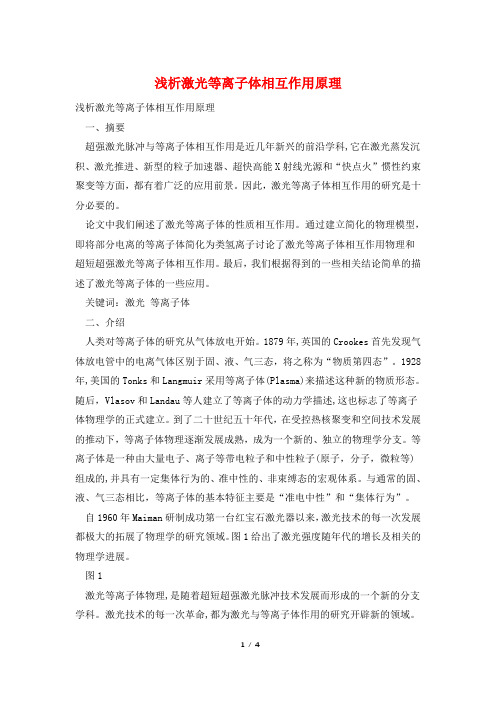
浅析激光等离子体相互作用原理浅析激光等离子体相互作用原理一、摘要超强激光脉冲与等离子体相互作用是近几年新兴的前沿学科,它在激光蒸发沉积、激光推进、新型的粒子加速器、超快高能X射线光源和“快点火”惯性约束聚变等方面,都有着广泛的应用前景。
因此,激光等离子体相互作用的研究是十分必要的。
论文中我们阐述了激光等离子体的性质相互作用。
通过建立简化的物理模型,即将部分电离的等离子体简化为类氢离子讨论了激光等离子体相互作用物理和超短超强激光等离子体相互作用。
最后,我们根据得到的一些相关结论简单的描述了激光等离子体的一些应用。
关键词:激光等离子体二、介绍人类对等离子体的研究从气体放电开始。
1879年,英国的Crookes首先发现气体放电管中的电离气体区别于固、液、气三态,将之称为“物质第四态”。
1928年,美国的Tonks和Langmuir采用等离子体(Plasma)来描述这种新的物质形态。
随后,Vlasov和Landau等人建立了等离子体的动力学描述,这也标志了等离子体物理学的正式建立。
到了二十世纪五十年代,在受控热核聚变和空间技术发展的推动下,等离子体物理逐渐发展成熟,成为一个新的、独立的物理学分支。
等离子体是一种由大量电子、离子等带电粒子和中性粒子(原子,分子,微粒等)组成的,并具有一定集体行为的、准中性的、非束缚态的宏观体系。
与通常的固、液、气三态相比,等离子体的基本特征主要是“准电中性”和“集体行为”。
自1960年Maiman研制成功第一台红宝石激光器以来,激光技术的每一次发展都极大的拓展了物理学的研究领域。
图1给出了激光强度随年代的增长及相关的物理学进展。
图1激光等离子体物理,是随着超短超强激光脉冲技术发展而形成的一个新的分支学科。
激光技术的每一次革命,都为激光与等离子体作用的研究开辟新的领域。
随着激光强度的不断增强,激光等离子体物理经历了从线性响应到非线性光学,再到相对论的非线性作用的研究历程。
在现有激光技术的推动下(强度S1023VI//cm2,脉宽/S量级),超短超强激光脉冲同等离子体的作用更是成为了当今物理学研究前沿的一个重要分支。
100 TW激光与等离子体相互作用中质子背向发射的能谱测量

! " $ =! 7 * 2 )+ , 3 2 4 ) / , + ’ 5 42 0 O. / + , " 3 ) # # 图 =! 激光焦斑和曲线
’ (( @( ?( A( * 质 子 成 像’ * + 快 点 火, 和 治 疗 癌 症’ 等 方 面 有 很 广 泛 的 应 用 前 景 % 最 近 +& 量高等特点 ! 在粒子 加 速 ’ ’ B( 这使得超短超强激光与等 5 M F N $ J O J O 等人用 ( )! CP( )! C 的双层微型靶首次得 到 了 : J # 的 准 单 能 质 子! ’( 离子体作用得到的质子作为离子源变得可行 $ 能量为十几 : Q& 3& 8 F J =* 等人用空心金锥靶得到发散角小 * J # ’ E( 的高能质子 $ 此 时 质 子 截 止 能 量 最 大# 成 线 性 关 系$ :& R < % D S 等人的实验得出 预 脉 冲 与 最 佳 靶 厚 " 7& 1 G T O I J > ’( 它的电子面密度 " 等于靶 $ U" 等人假设激光没有预脉冲时用多维的 . , 8 模拟得出产生的最大能量质子的靶 ! L 的厚度乘上靶的密度 # 与激光的功率密度的开方成正比 % 他们改变靶和激光参数得到不同能量质子和角分布 ! ! )( 的实验基础上 ! 采用更高能量的激光与薄靶进行相互作 对产生的质子束进行不断优化 % 我们在周伟民等人 ’
激光等离子体相互作用仿真软件VORPAL
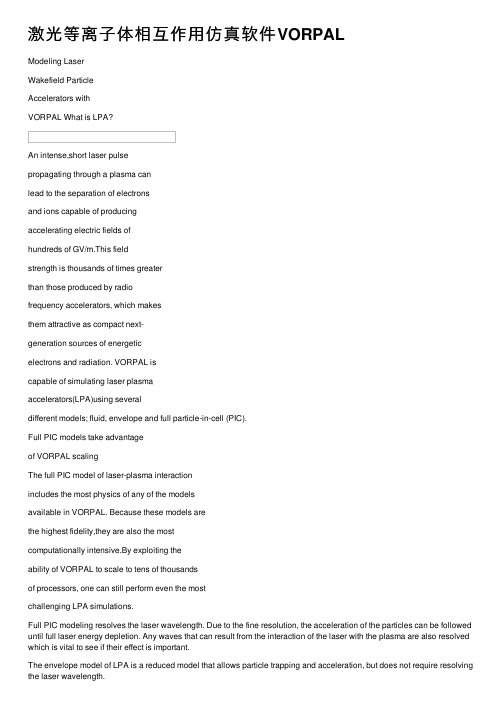
激光等离⼦体相互作⽤仿真软件VORPALModeling LaserWakefield ParticleAccelerators withVORPAL What is LPA?An intense,short laser pulsepropagating through a plasma canlead to the separation of electronsand ions capable of producingaccelerating electric fields ofhundreds of GV/m.This fieldstrength is thousands of times greaterthan those produced by radiofrequency accelerators, which makesthem attractive as compact next-generation sources of energeticelectrons and radiation. VORPAL iscapable of simulating laser plasmaaccelerators(LPA)using severaldifferent models; fluid, envelope and full particle-in-cell (PIC).Full PIC models take advantageof VORPAL scalingThe full PIC model of laser-plasma interactionincludes the most physics of any of the modelsavailable in VORPAL. Because these models arethe highest fidelity,they are also the mostcomputationally intensive.By exploiting theability of VORPAL to scale to tens of thousandsof processors, one can still perform even the mostchallenging LPA simulations.Full PIC modeling resolves the laser wavelength. Due to the fine resolution, the acceleration of the particles can be followed until full laser energy depletion. Any waves that can result from the interaction of the laser with the plasma are also resolved which is vital to see if their effect is important.The envelope model of LPA is a reduced model that allows particle trapping and acceleration, but does not require resolving the laser wavelength.laser oscillations, needing only to resolve the longerfor simulations can be several orders of magnitude with higher gain at low density where the plasma wavelength is much longer than the typical laserthe particle-in-cell method to follow particle motion,self-particle trapping and self-consistent acceleration by theTech-X Corporation/doc/b1faf204bed5b9f3f90f1ce1.html。
粒子模拟程序的发展及其在激光等离子体相互作用研究中的应用
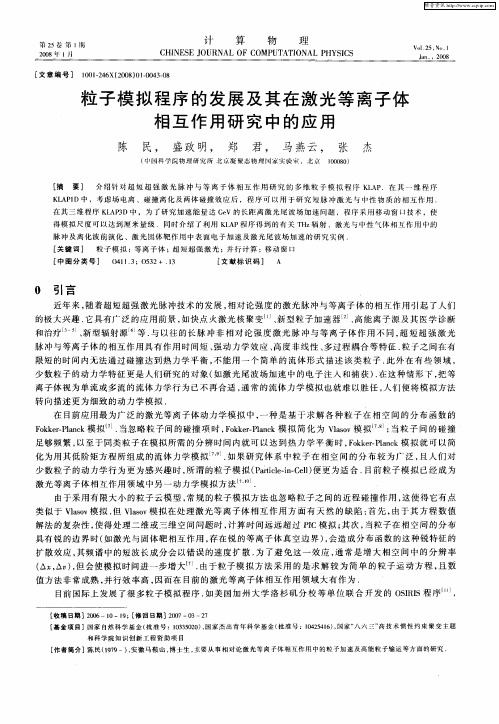
[ 文章 编 号 】 10 — 6 (0 80 — 4 —8 0 12 X 20 ) 1 0 30 4 0
粒 子模 拟 程序 的 发展 及 其在 激 光等 离 子体 相 互 作 用 研 究 中 的 应 用
陈 民 , 盛政 明, 郑 君 , 马 燕 云 , 张 杰
( } 科 学 院 物 理 研 究 所 北 京凝 聚 态 物 删 家 实 验 窜 ,北 京 1 0 0 r圈 1 0 8) 0
【 摘 要】 介绍针 对超 短超 强激 光 脉冲 与等离 子 体相 互作 用研 究 的多维 粒 子模拟 程序 K A .在 其 一维程 序 LP
KA I L P D中 ,考 虑 场 电离 、碰 撞 离 化 及 两 体 碰 撞 效 应 后 ,程 序 可 以 用 于研 究 短 脉 冲 激 光 与 中性 物 质 的 相 互 作 用 . 在 其 三 维 程 序 K A 3 中 , 为 了研 究加 速 能 量 达 G V的 长距 离 激 光 尾 波 场 加 速 问 题 ,程 序 采 用 移 动 窗 口技 术 ,使 L PD e 得 模 拟 尺 度 可 以 达 到 厘 米 量 级 .同 时 介 绍 了利 用 K A L P程 序 得 到 的 有 关 T z 射 、激 光 与中性 气 体 相 互 作 用 中的 H辐 脉 冲 及 离 化 波 前 演化 、激 光 固 体 靶 作 用 中表 面 电子 加 速 及激 光 尾波 场加 速 的 研 究 实 例 ,
少数粒 子 的动力 学行 为更 为感兴 趣 时 , 所谓 的粒子 模拟 ( a i ei—e ) Prc — C l 便更 为适 合 . tl n 1 目前粒 子模 拟 已经成 为 激光 等离 子体相 互作用 领 域 中另一 动力学 模 拟方 法” . ’ 由于 采用有 限大 小 的粒子 云模 型 , 规 的粒 子模拟 方法 也忽 略粒 子之 间的近程 碰撞 作用 , 常 这使 得它有 点 类似 于 Vao 模拟 . Vao l v s 但 ls v模拟 在处 理激 光 等离 子体 相互 作 用 方 面有 天 然 的缺 陷 : 先 , 首 由于其 方 程数 值 解法 的复杂 性 , 使得处 理二 维 或三维 空 间问题 时 , 计算 时 间远 远超 过 PC模 拟 ; 次 , I 其 当粒 子在 相空 间 的分 布 具有 锐的边 界 时( 激光 与 固体 靶 相互作 用 , 如 存在 锐 的等离 子体 真空边 界 ) 会造 成 分布 函数 的这种 锐特征 的 ,
eclip实验的原理和应用
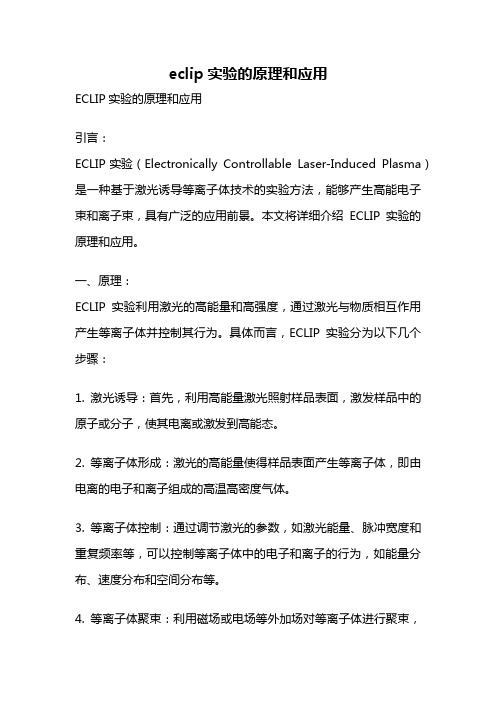
eclip实验的原理和应用ECLIP实验的原理和应用引言:ECLIP实验(Electronically Controllable Laser-Induced Plasma)是一种基于激光诱导等离子体技术的实验方法,能够产生高能电子束和离子束,具有广泛的应用前景。
本文将详细介绍ECLIP实验的原理和应用。
一、原理:ECLIP实验利用激光的高能量和高强度,通过激光与物质相互作用产生等离子体并控制其行为。
具体而言,ECLIP实验分为以下几个步骤:1. 激光诱导:首先,利用高能量激光照射样品表面,激发样品中的原子或分子,使其电离或激发到高能态。
2. 等离子体形成:激光的高能量使得样品表面产生等离子体,即由电离的电子和离子组成的高温高密度气体。
3. 等离子体控制:通过调节激光的参数,如激光能量、脉冲宽度和重复频率等,可以控制等离子体中的电子和离子的行为,如能量分布、速度分布和空间分布等。
4. 等离子体聚束:利用磁场或电场等外加场对等离子体进行聚束,使电子和离子束具有一定的定向性和聚焦度。
5. 高能束流产生:通过适当的调节和控制,使电子束和离子束具有较高的能量,可用于研究材料的性质、辐照治疗、离子注入等应用。
二、应用:ECLIP实验具有广泛的应用前景,以下是该实验在不同领域的应用示例:1. 材料科学:ECLIP实验可以用于研究材料的性质和相变过程。
通过调节等离子体中的电子和离子束的能量和密度,可以模拟材料在极端条件下的行为,如高温、高压等。
这有助于深入理解材料行为,并指导材料设计和制备。
2. 生命科学:ECLIP实验可以用于生物医学研究,如肿瘤治疗和基因传递等。
利用高能电子束和离子束对肿瘤进行辐照治疗,可以精确破坏肿瘤细胞,减少对周围正常组织的伤害。
此外,电子束还可以用于基因传递,将外源基因导入细胞内,实现基因治疗。
3. 环境科学:ECLIP实验可以用于环境污染监测和治理。
通过激光诱导等离子体技术,可以将污染物转化为更稳定的形式或破坏其分子结构,从而降低其毒性和环境影响。
激光诱导等离子体光谱法(LIPS)及其影响因素
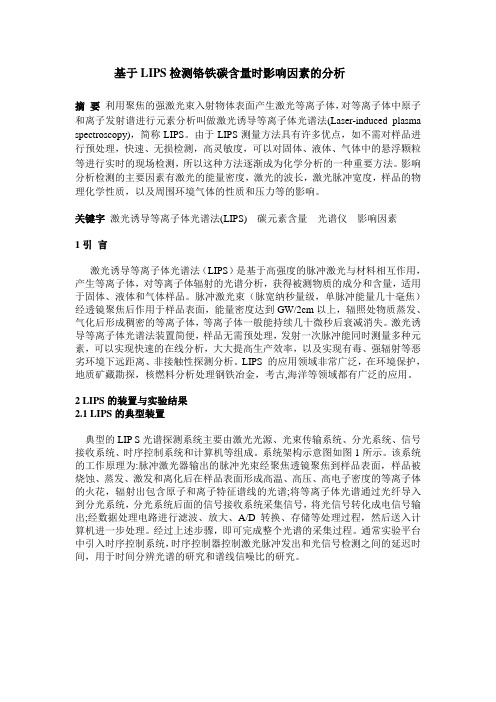
基于LIPS检测铬铁碳含量时影响因素的分析摘要利用聚焦的强激光束入射物体表面产生激光等离子体,对等离子体中原子和离子发射谱进行元素分析叫做激光诱导等离子体光谱法(Laser-induced plasma spectroscopy),简称LIPS。
由于LIPS测量方法具有许多优点,如不需对样品进行预处理,快速、无损检测,高灵敏度,可以对固体、液体、气体中的悬浮颗粒等进行实时的现场检测,所以这种方法逐渐成为化学分析的一种重要方法。
影响分析检测的主要因素有激光的能量密度,激光的波长,激光脉冲宽度,样品的物理化学性质,以及周围环境气体的性质和压力等的影响。
关键字激光诱导等离子体光谱法(LIPS) 碳元素含量光谱仪影响因素1引言激光诱导等离子体光谱法(LIPS)是基于高强度的脉冲激光与材料相互作用,产生等离子体,对等离子体辐射的光谱分析,获得被测物质的成分和含量,适用于固体、液体和气体样品。
脉冲激光束(脉宽纳秒量级,单脉冲能量几十毫焦)经透镜聚焦后作用于样品表面,能量密度达到GW/2cm以上,辐照处物质蒸发、气化后形成稠密的等离子体,等离子体一般能持续几十微秒后衰减消失。
激光诱导等离子体光谱法装置简便,样品无需预处理,发射一次脉冲能同时测量多种元素,可以实现快速的在线分析,大大提高生产效率,以及实现有毒、强辐射等恶劣环境下远距离、非接触性探测分析。
LIPS 的应用领域非常广泛,在环境保护,地质矿藏勘探,核燃料分析处理钢铁冶金,考古,海洋等领域都有广泛的应用。
2 LIPS的装置与实验结果2.1 LIPS的典型装置典型的LIP S光谱探测系统主要由激光光源、光束传输系统、分光系统、信号接收系统、时序控制系统和计算机等组成。
系统架构示意图如图1所示。
该系统的工作原理为:脉冲激光器输出的脉冲光束经聚焦透镜聚焦到样品表面,样品被烧蚀、蒸发、激发和离化后在样品表面形成高温、高压、高电子密度的等离子体的火花,辐射出包含原子和离子特征谱线的光谱;将等离子体光谱通过光纤导入到分光系统,分光系统后面的信号接收系统采集信号,将光信号转化成电信号输出;经数据处理电路进行滤波、放大、A/D转换、存储等处理过程,然后送入计算机进一步处理。
第三章 激光产生的等离子体的解析模型
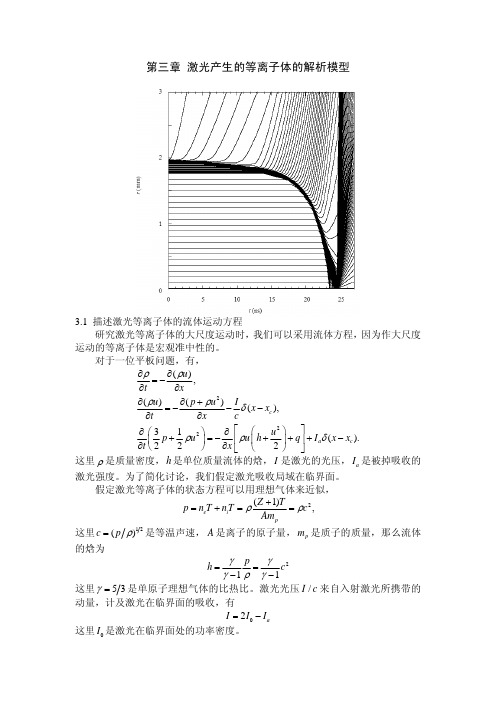
此时临界密度面的速度为声速
为了维持等离子体的等温膨胀,需要不断地有能量流入冕区。将能量方程从 临界面到 x = +∞ 积分,再利用上述自相似解的结果,有
3 q2 = ρ c c0
这里 c0 是临界密度面的声速。能流 q2 只能来自被吸收的激光功率密度。 等温近似在电子温度梯度标长 LT = T / (dT / dx) 大于等离子体特征尺度时成 立。等离子体特征尺度为 L ∼ cτ L 那么等温条件近似为 LT > cτ L 假定被吸收的激光能量的一部分是以电子热传导的形式流入冕区, 为了维持等温 膨胀所需要的能流为 T 7/2 q1 = ρc c3 = κ LT 这里 κ 是个与电子温度无关的常数。综合上述条件,冕区等离子体能够发生等温 膨胀的条件为 T > (τ L ρ c κ ) 2 3 ⎡ ⎣( Z + 1) ( Am p ) ⎤ ⎦
3.3 冕区等离子体的自相似膨胀 3.3.1 等温近似 物质在激光辐照的作用下向真空膨胀,形成冕区。在等温近似下,流体力学 方程在冕区有自相似解, x u ( x, t ) = c + , t ρ ( x, t ) = ρ 0 exp [ − x ct ] . 以临界密度面作为坐标起点,那么有
u ( x, t ) = c + x − xx , t ρ ( x, t ) = ρ c exp [ −( x − xc ) ct ] .
γ
p
γ −1 ρ
=
γ γ −1
c2
这里 γ = 5 3 是单原子理想气体的比热比。激光光压 I / c 来自入射激光所携带的 动量,计及激光在临界面的吸收,有 I = 2I0 − I a 这里 I 0 是激光在临界面处的功率密度。
激光与金属铜相互作用产生的等离子体的实验测量

激光与金属铜相互作用产生的等离子体的实验测量过去的几十年中,关于飞秒激光和等离子体的相互作用的研究非常的热门。
特别是使用飞秒激光诱导的击穿光谱(LIBS)和等离子体的相互作用关系的问题大家讨论地最多。
本论文的工作就是在标准的大气压中,使用激光诱导的击穿光谱对纳秒激光诱导的金属铜等离子体发射光谱进行测量研究,探索了不同能量的激光对金属铜等离子体发射的光谱强度和金属铜等离子体的温度以及电子的密度随时间的变化关系。
通过实验,我们得出了随着时间地增大,相同的激光能量下,金属铜等离子体发射的谱线强度会逐渐地下降,特别是在0.8ms到1.8ms时,谱线强度下降地比较快,然后下降的速度会变缓并慢慢地降到零;电子密度的变化情况和谱线强度的变化相一致;等离子体温度却是随着时间增加,慢慢地下降。
关键词:纳秒激光;等离子体;光谱;温度和电子密度;时间演化第一章绪论1.1 激光诱导击穿光谱简介最近20年来,有关激光诱导等离子体(Laser-induced plasma)的研究工作特别的热,而激光诱导等离子体发射光谱(激光诱导击穿光谱)是一种探究激光与材料相互作用非常有效的方法,所以在最近的十几年中里该方法倍受大家的关注。
使用激光诱导击穿光谱能够很快的得到激光诱导的等离子体的很多特性,比如说等离子体温度、等离子体中电子数密度、等离子体中原子和离子个数。
另外,激光诱导的击穿光谱在元素的分析过程中更是有其着其独一无二的优势。
第一,这种方法是通过分析元素的特征光谱来分析此样品,这种方法可以对任何一种的元素进行分析研究,被研究的物质能够是固体、液体或者说气体,用另一句话说就是说这种分析技术对待分析样品的物理状态是没有要求的。
第二,这个分析研究是一个光学分析的物理过程,只要让激光和被待检测的样品相互接触,这样使得远距离的分析和很快安全的对那些不知危险的样品的分析研究变得更加简单。
第三,纳米激光诱导的击穿光谱分析技术只要将纳米激光聚焦在特别小的面积上之后,最小的聚焦面积可以达到平方微米的量级,这样的话,只要有特少的待测样品就能够进行分,也就是说分析的精度特别高。
浅析激光等离子体相互作用原理

浅析激光等离子体相互作用原理一、摘要超强激光脉冲与等离子体相互作用是近几年新兴的前沿学科,它在激光蒸发沉积、激光推进、新型的粒子加速器、超快高能X射线光源和“快点火”惯性约束聚变等方面,都有着广泛的应用前景。
因此,激光等离子体相互作用的研究是十分必要的。
论文中我们阐述了激光等离子体的性质相互作用。
通过建立简化的物理模型,即将部分电离的等离子体简化为类氢离子讨论了激光等离子体相互作用物理和超短超强激光等离子体相互作用。
最后,我们根据得到的一些相关结论简单的描述了激光等离子体的一些应用。
关键词:激光等离子体二、介绍人类对等离子体的研究从气体放电开始。
1879年,英国的Crookes首先发现气体放电管中的电离气体区别于固、液、气三态,将之称为“物质第四态”。
1928年,美国的Tonks和Langmuir采用等离子体(Plasma)来描述这种新的物质形态。
随后,Vlasov和Landau等人建立了等离子体的动力学描述,这也标志了等离子体物理学的正式建立。
到了二十世纪五十年代,在受控热核聚变和空间技术发展的推动下,等离子体物理逐渐发展成熟,成为一个新的、独立的物理学分支。
等离子体是一种由大量电子、离子等带电粒子和中性粒子(原子,分子,微粒等)组成的,并具有一定集体行为的、准中性的、非束缚态的宏观体系。
与通常的固、液、气三态相比,等离子体的基本特征主要是“准电中性”和“集体行为”。
自1960年Maiman研制成功第一台红宝石激光器以来,激光技术的每一次发展都极大的拓展了物理学的研究领域。
图1给出了激光强度随年代的增长及相关的物理学进展。
图1激光等离子体物理,是随着超短超强激光脉冲技术发展而形成的一个新的分支学科。
激光技术的每一次革命,都为激光与等离子体作用的研究开辟新的领域。
随着激光强度的不断增强,激光等离子体物理经历了从线性响应到非线性光学,再到相对论的非线性作用的研究历程。
在现有激光技术的推动下(强度S 1023VI//cm2,脉宽/S 量级),超短超强激光脉冲同等离子体的作用更是成为了当今物理学研究前沿的一个重要分支。
强激光等离子体耦合效应的数值模拟

第9卷第3期强激光与粒子束V o l.9,N o.31997年8月H IGH POW ER LA SER AND PA R T I CL E BEAM S A ug.,1997强激光等离子体耦合效应的数值模拟屠琴芬俞汉清陈志华Ξ(西北核技术研究所,西安69信箱15分箱,710024摘要研究了高强度(1012~1014W c m2,纳秒脉冲(高斯型激光与A l、CH等离子体的耦合效应。
采用一维双温、单流体力学方程组,数值模拟研究激光强度和波长对靶表面能量沉积和对等离子体特征参数的影响。
激光等离子体耦合的主要机制有:轫致辐射、逆轫致辐射吸收、热扩散和电子、离子之间碰撞能量交换。
给出了电子最高温度与光强的近似定量关系。
关键词强激光等离子体耦合效应数值模拟ABSTRACT T he coup ling effect of h igh2in ten sity nano second laser pu lse w ith A l o r CHp las m as are studied u sing the hydrodynam ical equati on s w h ich are one2di m esi onal,doub le2tem2peratu re,single2flu id.T he effects of laser in ten sity and w avelength on energy depo siti on in thetarget su rface and p las m a param etes are num erically investigated.T he m ain m echan is m oflaser p las m a coup ling includes the free2free b rem sstrah lung em issi on,inverse b rem sstrob lungab so rp ti on,the heat diffu ssi on and energy exchange betw een electron s and i on s.T he ap rox i2m ate scales of m ax i m um electron temperatu re give ou t w ith respect to the laser in ten sity.KEY WOR D S h igh in ten sity laser,p las m a,coup ling effect,num erical si m u lati on对垂直入射靶表面的高强度激光的能量沉积过程,以及激光与等离子体的耦合效应进行了数值模拟。
粒子模拟程序的发展及其在激光等离子体相互作用研究中的应用

[文章编号] 1001 246X(2008)01 0043 08[收稿日期]2006-10-19;[修回日期]2007-03-27[基金项目]国家自然科学基金(批准号:10335020)、国家杰出青年科学基金(批准号:10425416),国家 八六三 高技术惯性约束聚变主题和科学院知识创新工程资助项目[作者简介]陈民(1979-),安徽马鞍山,博士生,主要从事相对论激光等离子体相互作用中的粒子加速及高能粒子输运等方面的研究.粒子模拟程序的发展及其在激光等离子体相互作用研究中的应用陈 民, 盛政明, 郑 君, 马燕云, 张 杰(中国科学院物理研究所北京凝聚态物理国家实验室,北京 100080)[摘 要] 介绍针对超短超强激光脉冲与等离子体相互作用研究的多维粒子模拟程序KLAP.在其一维程序KLAP1D 中,考虑场电离、碰撞离化及两体碰撞效应后,程序可以用于研究短脉冲激光与中性物质的相互作用.在其三维程序KLAP3D 中,为了研究加速能量达GeV 的长距离激光尾波场加速问题,程序采用移动窗口技术,使得模拟尺度可以达到厘米量级.同时介绍了利用KLAP 程序得到的有关THz 辐射、激光与中性气体相互作用中的脉冲及离化波前演化、激光固体靶作用中表面电子加速及激光尾波场加速的研究实例.[关键词] 粒子模拟;等离子体;超短超强激光;并行计算;移动窗口[中图分类号] O411 3;O532+ 13[文献标识码] A0 引言近年来,随着超短超强激光脉冲技术的发展,相对论强度的激光脉冲与等离子体的相互作用引起了人们的极大兴趣.它具有广泛的应用前景,如快点火激光核聚变[1]、新型粒子加速器[2]、高能离子源及其医学诊断和治疗[3-5]、新型辐射源[6]等.与以往的长脉冲非相对论强度激光脉冲与等离子体作用不同,超短超强激光脉冲与等离子体的相互作用具有作用时间短、强动力学效应、高度非线性、多过程耦合等特征.粒子之间在有限短的时间内无法通过碰撞达到热力学平衡,不能用一个简单的流体形式描述该类粒子.此外在有些领域,少数粒子的动力学特征更是人们研究的对象(如激光尾波场加速中的电子注入和捕获).在这种情形下,把等离子体视为单流或多流的流体力学行为已不再合适,通常的流体力学模拟也就难以胜任,人们便将模拟方法转向描述更为细致的动力学模拟.在目前应用最为广泛的激光等离子体动力学模拟中,一种是基于求解各种粒子在相空间的分布函数的Fokker Planck 模拟[7].当忽略粒子间的碰撞项时,Fokker Planck 模拟简化为Vlasov 模拟[7,8];当粒子间的碰撞足够频繁,以至于同类粒子在模拟所需的分辨时间内就可以达到热力学平衡时,Fokker Planck 模拟就可以简化为用其低阶矩方程所组成的流体力学模拟[7,9].如果研究体系中粒子在相空间的分布较为广泛,且人们对少数粒子的动力学行为更为感兴趣时,所谓的粒子模拟(Particle in Cell)便更为适合.目前粒子模拟已经成为激光等离子体相互作用领域中另一动力学模拟方法[7,10].由于采用有限大小的粒子云模型,常规的粒子模拟方法也忽略粒子之间的近程碰撞作用,这使得它有点类似于Vlasov 模拟.但Vlasov 模拟在处理激光等离子体相互作用方面有天然的缺陷:首先,由于其方程数值解法的复杂性,使得处理二维或三维空间问题时,计算时间远远超过PIC 模拟;其次,当粒子在相空间的分布具有锐的边界时(如激光与固体靶相互作用,存在锐的等离子体真空边界),会造成分布函数的这种锐特征的扩散效应,其频谱中的短波长成分会以错误的速度扩散.为了避免这一效应,通常是增大相空间中的分辨率( x , v ),但会使模拟时间进一步增大[7].由于粒子模拟方法采用的是求解较为简单的粒子运动方程,且数值方法非常成熟,并行效率高,因而在目前的激光等离子体相互作用领域大有作为.目前国际上发展了很多粒子模拟程序.如美国加州大学洛杉矶分校等单位联合开发的OSIRIS 程序[11],第25卷第1期2008年1月计 算 物 理 C HI NESE JOURNAL OF C OMP UTATI ONAL PHYSICS Vol.25,No.1J an.,2008它是一个全相对论,全并行,全隐格式,且包含场及碰撞离化的大型程序.应用该程序在尾波场加速方面取得了丰富的结果;Pukhov在德国马普量子光学所开发的VLPL(Virtual Laser Plasma Lab)程序[12]也是最为著名的并行PIC程序之一,在激光自聚焦,激光尾波场加速,通道内的Betatron加速等方面取得了很多重要成果;日本大阪大学正在为快点火聚变研究开发一个集成程序FI3(Fast Ignition Integrated Interconnecting code),该集成程序计划包含二维流体力学程序,三维粒子模拟程序,三维Fokker Planck程序及三维混合程序,其中粒子模拟程序在研究快点火的相关问题中也起了极其关键的作用[13];另外还有许多各具特色的粒子模拟程序[14].迄今为止公开的粒子模拟程序并不多,应用广泛的只有马普量子光学研究所Lichters发展的1D3V程序LPIC++,它是一个用面向对象语言C++编制的程序,单机或并行均可以计算.在发展用于激光与等离子体相互作用的粒子模拟程序的研究中,北京应用物理和计算数学研究所先后编写了2D3V和3D3V的并行程序LARED P,并将其应用到激光聚变的研究中;国防科技大学徐涵编写了2D3V并行程序PPIC C[14],马燕云编写了二维,三维并行PIC程序PLASI M2D,3D(PLASMA SI MULATOR)等[15].近年来,中科院物理所为研究激光等离子体相互作用,编写了多维并行的粒子模拟程序KLAP(Kinetic LAser Plasmas).本文将主要给出在其粒子模拟中加入场电离、碰撞效应及采用移动窗口的技术,同时给出近期取得的一些成果.1 粒子模拟程序中加入场电离及粒子碰撞通常的粒子模拟程序主要处理电磁场与完全离化的等离子体相互作用,其算法经历了近40年的发展,已经相当成熟[16].然而当强激光与中性物质相互作用时,首先涉及的物理过程是中性物质在激光场中的电离过程.为此在原有的一维粒子模拟程序(KLAP1D)基础上加入场电离子程序[17,18].程序中场电离模型采用Penetrante和Bardsley基于ADK模型的表述形式i=6 6!1016Z 2n4 5eff 10 87Z3n4effE hE(t)2neff-1 5exp-23Z3n3effE hE(t)s-1,(1)其中E h∀m2e e5-4=5 14!109V#cm-1为原子单位的电场强度;n eff=Z E i 13 6为被离化原子的有效主量子数,E i是以e V为单位的离化能;E(t)为原子感受到的电场强度.该式比ADK公式简单,利于数值计算,且在较高光强下与实验结果符合很好.程序中,在每一个时间步长 t内,先计算出原子离化概率P op t=1-e xp{- i[E(t)] t},然后产生[0,1]间均匀分布的随机数q,当且仅当q∃P opt时原子离化,产生一个电子及一个离子.对于原子的高次离化,在产生一个新电子的同时,只是使得原有离子的电荷数加一,而不再产生新离子.由于气体密度大,我们用虚拟离化电流的方法处理由于光离化而引起的光场能量损失.为此,在每一计算步内均需计算由于离化产生的离化电流J ion=%in e i(E i+!ki)t|E(t)|2E(t),(2)其中 n e i为单个时间步长内第i价离子电离出的电子数密度,!ki是电子刚电离出来时的动能.该离化电流在每一循环内都将与带电粒子运动产生的实际电流相加,带入麦克斯维方程组求下一步电场.如果研究所涉及的气体密度较高,随着离化的进行,等离子密度迅速增加,碰撞离化将达到可以与光离化相比拟的程度.这种情况下,仅在粒子模拟中加入光离化是不够的,因此在现有一维粒子模拟程序中还加入了电子碰撞电离子程序,该碰撞电离过程对所有未完全离化的离子及中性原子均作处理.对于一个速度为v e的电子,它与序数为Z的原子的各种碰撞电离截面的和为∀tot(E e)=%Z-1i=0∀i(E e)=v e%Z-1i=0#i(E e)n i(x),(3)其中E e为碰撞电子的动能,#i(E e)为电子碰撞电离截面,n i(x)为第i价离子的数密度.在 t内,该电子总的电子碰撞电离几率为P e=1-exp{-∀tot(E e) t}.与Vahedi和Surendra[18]类似,程序中电子与离子的碰撞电离是在一个粒子模拟网格内,网格大小在程序模拟时与德拜球的大小相当.一旦电子发生碰撞电离,其动能将相应减少以补偿电离能,但电子运动方向不变.具体过程如下:对于一网格内所有种类离子,首先计算出44计 算 物 理第25卷一个虚拟电子的最大碰撞频率,它与该网格内的各价离子总的碰撞频率为∀max =%Z -1i =0n i(x )max v e {<#i v e >}.其中求最大值运算是对网格中的所有真实电子的可能速度而言,尖括号表示该碰撞截面#i 是对电子能量取麦克斯韦分布后得到的,且麦克斯韦分布的平均速度为v e .由此计算出该网格内任意一个电子的最大电子碰撞几率P emax =1-exp{-∀max t },然后从网格内随机选出P emax N e 个电子(N e 为该网格内电子数),对每一个电子用如下方法决定它参与何种形式的碰撞电离.首先对所选电子构造数列{a 0,a 1,&&,a Z -1}=0,∀0(E e )∀max ,∀0(E e )+∀1(E e )∀max ,&,%Z -1i =0∀i (E e )∀max ,(4)然后选[0,1]间均匀分布的随机数R ,当a k ∃R ∃a k +1(0∃k ∃Z -2)时,发生离子从k 价到k +1价的电离,随机选定同一网格内相应价态的一个离子进行离化,产生新电子;当R ∋a Z -1时,离化不发生.如果由于时间步长太小,以至于单个时间步长内每个网格中P emax N e <1,则对每步的P emax N e 进行累加,直到P emax N e >1为止,进行离化判定,而后将P emax N e 归零,再继续进行计算.为了使1DPIC MCC 程序可以应用到激光斜入射情形,按通常做法,对模拟体系做一个整体的相对论变换.在这种情形下,碰撞电离是转换到实验室坐标系下计算的,之后再转换回运动系进行通常的粒子模拟计算.程序中假定气体原子初速度均为零,所有刚电离出的电子初速度与产生它的原子或离子速度一样,新产生的电子和离子在下一个程序循环中与电磁场发生作用.若程序中不考虑粒子之间的碰撞效应,经光离化和碰撞离化后产生的等离子体将很难在短时间内达到平衡.由于通常的粒子模拟程序无法处理粒子间在德拜球内的近距离碰撞相互作用,为此,在程序中加入粒子间的两体碰撞[18],以使程序因处理粒子间的近程库仑碰撞,从而弥补通常粒子模拟程序因采用有限粒子云大小方法而带来的不足.所有碰撞过程均在两粒子的质心系中进行,而后变换回模拟所选用的参考系[19].对于速度和质量分别为(v 1,m 1),(v 2,m 2)的两个相对论粒子,其质心系速度为v cm =∃1m 1v 1+∃2m 2v 2∃1m 1+∃2m 2,(5)在质心系中两粒子速度为v i ,cm =(∃cm -1)v cm #v i v 2cm v cm +v i -∃cm v c m ∃cm 1-v cm #v i c 2,(6)式中∃cm 为质量中心的相对论因子.两粒子的碰撞频率∀12=4%(e 1e 2)2min(n 1,n 2)&p 2r el v rel,n i 为第i 种粒子的密度,e i 为第i 种粒子的电量,p rel 和v vel 分别为相对动量和速度,&为库仑碰撞指数.碰撞后两粒子在质心系中的动量为P (1=P 1+ P ,P (2=P 2- P ,其中P 1,P 2为其碰撞前在质心系中的动量,满足P 1=(p x ,p y ,p z )=-P 2, P =( P x , P y , P z ),P x =(p x p ))p z sin ∋cos (-(p y p ))p sin ∋sin (-p x (1-cos ∋),P y =(p y p ))p z sin ∋cos (+(p x p ))p sin ∋sin (-p y (1-cos ∋),P z =-p )sin ∋cos (-p z (1-cos ∋),(7)其中p )=p 2x +p 2y ,(是在质心系中相对于矢量P 1的方位角,满足[0,2%]间的均匀分布;∋是俯仰角,对于小角度散射(∀12∃cm t <0 5, t 为两碰撞计算步的时间间隔),tan(∋ 2)满足平均值为0,方差<tan 2(∋ 2)>=∀12∃cm t 的高斯分布.程序中用Maraglia 方法进行高斯抽样,得到∋值.对于大角度散射,c os ∋满足均匀分布.求得粒子在质心系中碰撞后的速度,再对粒子做相对论变换到模拟所选参考系,使其重新进入通常的粒子模拟计算.对于参与碰撞的粒子对的选择,我们的方法与Takizuba 和Abe 相同[20].首先对一个网格内的所有同种粒子(电子类,各价带电离子视为一类)随机排序.其次对同种粒子(图1(a),(b))选择碰撞对,图1(a)为粒子数为偶数的情形,图1(b)为粒子数为奇数的情形;对于异种粒子间的碰撞,如图1(c)所示选择碰撞45第1期陈 民等:粒子模拟程序的发展及其在激光等离子体相互作用研究中的应用图1 两体碰撞对的划分Fig.1 Selection of pairs for two bodycollisions对.假设离子数N i 大于等于电子数N e ,N i N e =i +r ,0∃r <1,i 为正整数,将离子和电子分为两组,其中前(i +1)r N e 个离子和rN e 个电子分为一组,后i (1-r )N e 个离子和(1-r )N e 个电子为第二组.第一组中每个电子与第一组中的i +1个离子组成碰撞对,第二组中每个电子与第二组中的i 个离子组成碰撞对.当电子数多于离子数时类似处理,而电子数与离子数相同时就成了电子与离子按序号对应碰撞.2 移动窗口的使用对于激光尾波场加速及激光在等离子体中的自聚焦传输等问题,需要模拟的空间在激光传输方向上往往有很长的距离(cm 量级);而我们感兴趣的区域却只局限于有限的光脉冲及后续几个尾波场段.对于这类问题,不可能也不必对整个激光传播区域进行模拟,只需模拟跟踪激光脉冲传播的有限区域.模拟的区域(称为模拟窗口)随着光脉冲一起向前传播,这就是所谓的移动窗口技术.通常为了避免由于窗口移动而造成的后向粒子,场的数据损失对于窗口区域的影响,窗口以真空中的光速进行移动.由于光脉冲在等离子体传播的速度小于真空中的光速,所以为了避免光脉冲在窗口中向后滑移,甚至移出窗口,通常窗口的大小必须事先估计好.对于长距离传输,移动窗口本身的尺度通常也很大,必须对窗口进行并行处理,所以移动窗口技术与并行计算兼而有之.对于窗口末端移出的粒子,直接从链表中删除;每次窗口向前移动一格,整个场的值也需要整体移动一格,相应的也需要进行进程间的通信.对于窗口前端进来的粒子,要进行动量初始化,使其满足一定温度下的波尔滋曼分布.3 几个典型的应用实例经过多年的发展,如今粒子模拟程序已经是研究激光等离子体相互作用领域中不可或缺的手段,为实验和理论研究建立起一个桥梁,为理解强激光与等离子体作用物理提供了非常形象的帮助.由于它可以精确到对单个粒子的轨迹进行跟踪,又能对宏观体系进行统计分析,对场的结构在时空上无限制的探测,因而,应用领域空前广泛.我们仅以近期的4个工作为例,对KLAP 系列程序的功能做一示范.3 1 利用KLAP 1D 研究激光等离子体THz 辐射源人们可以用超短激光脉冲在稀薄等离子体中激发出大振幅的电子等离子体波,称为激光尾波场.这种大振幅等离子体波的典型振动频率在太赫兹附近.虽然其振幅很大,但由于它是静电波,具有与电磁波完全不同的色散关系,因此一般不能从中产生辐射.等离子体波的色散关系为 2= 2p +3k 2v 2e ;等离子体中电磁波的色散关系为 2= 2p +k 2c 2.在均匀等离子体中激发的等离子体波的波数k ∗0,因此一般不可能产生模式转换现象.但在不均匀等离子体中,由于等离子体波在各处的振荡频率不同,由此导致等离子体波数随时间和空间发生变化.在某些时刻,波矢k =0,等离子体波的色散关系和等离子体中电磁波的色散关系重合,等离子体波就可能转换成电磁波[21].这种转换方式被称为线性模式转换.但波数为零不是产生模式转换的唯一条件.由于等离子体波是静电纵波,而电磁波是横波,如果两者传播方向一样,则它们的电场方向相互垂直,因而也不能产生模式转换.如果入射激光的方向和等离子体密度梯度方向有一个夹角,那么造成两者的电场分量部分地平行,线性模式转换就可以发生.图2(a)给出产生模式转换的示意图,表示产生的低频电磁辐射相当于在入射光的反射方向.为了能够在一维模型中处理激光斜入射到等离子体的作用,需要将系统所有变量沿图2(a)y 轴方向做一个坐标变换到c sin ∋y 的坐标中.在新的移动坐标系中,激光垂直入射到以速度-c sin ∋y 运动的等离子体流46计 算 物 理第25卷图2 激光等离子体相互作用中THz 辐射的产生Fig.2 THz generation in laser plasmainteraction 上.将计算结果再重新转换到实验室坐标后,就得到激光以斜入射作用到等离子体的问题.图2(b),(c)给出一个数值模拟计算结果.它表明有很强的低频辐射从等离子体传播到真空区(x )0<50).对于~1017W #cm -2的入射激光强度,可以产生电场强度达GV #m -1,频率在十几THz 的辐射,其瞬时功率高达几十MW,脉宽在几十ps,能量为几十个∗J.这个辐射除可以作为强太赫兹辐射源外,还可以用来诊断等离子体波的振幅.后者对新型粒子加速器研究非常重要,目前国内外多个实验室在准备探测这种等离子体波辐射.3 2 利用KLAP 1D 程序研究激光与中性气体相互作用中的脉冲和离化波前的演化强激光脉冲在气体中传播时,气体将被其前沿迅速电离,产生的离化波前随激光脉冲前沿一起以近光速传播.利用带离化子程序的KLAP1D 程序,对光脉冲与离化波前的相互作用进行模拟研究,讨论在原子多度电离的情况下,光脉冲与离化波前的相互作用关系[17].模拟中的激光波长固定为800nm,脉冲包络为E (t )=E 0sin 2(%t T ),其中脉宽T =25T 0+66 7fs,T 0为激光周期.激光强度由关系式I )20=1 38!1018a 20W #c m -2#∗m -2给出,其中)0为以∗m 为单位的激光波长,a 0=eE 0 m 0c 为归一化的电场强度峰值,-e 为电子电量,m 为电子质量, 0和c 为激光频率和真空中的光速.材料介质的密度以临界密度n c =!0m 20e 2+1 74!1021c m -3为单位.长度和时间单位分别用激光波长和周期做归一化处理.我们模拟研究电场振幅峰值a 0=0 05的激光与密度为0 05n c 的氧气相互作用.由图3可见,由于原子各级离化势的不连续性使得离化波前在空间上出现平台区;离化过程导致激光频率发生蓝移,这个蓝移又对脉冲形状产生调制,使脉冲前沿呈阶跃型增长;阶跃型的光脉冲包络使离化波前的平台区变短,直至整个离化波前分为几个不同梯度的区域.图4展示了光脉冲频率随传播距离的关系,研究表明出射的光脉冲在基频和二倍频之间,频谱的精细结构是缘于光脉冲宽度的增加及光脉冲前后沿频率的不同.前后沿不同频率的光脉冲间的时间差随传播距离的增加图3 超短脉冲激光与氧气作用中通过场电离产生的电子密度分布和相应激光的电场分布Fig.3 Distribution of electron densi ty and laserelectric field in the i nteraction oflaser pulse with oxygengases 图4 电场振幅峰值a 0=0 02的激光与密度为0 2n c 的氧气相互作用时,在气体中不同位置处激光的频谱Fig.4 Frequency spectrum of the laser pulse at differen t positions during interaction of laser pulse with oxygen gases with a 0=0 02and density of oxygen gases 0 2n c 47 第1期陈 民等:粒子模拟程序的发展及其在激光等离子体相互作用研究中的应用而增加,这导致在出射光的频谱中精细结构的数目也不断增加.3 3 利用KLAP 2D 研究激光与平面靶相互作用中电子的表面发射2006年,我们在实验中发现,当功率密度为2!1018W #cm -2,脉宽为30fs 的超短超强激光脉冲,以70,角入射到厚度为30∗m 的平面铝靶上时,在靶面方向上会出现高能的准直电子束[22],可测量到的最大电子能量达到2MeV.图5给出实验测量到的电子角分布曲线.这种电子发射与以往结果不同.通常当超短超强激光脉冲与固体靶相互作用时,靶前的电子发射或者来源于共振吸收,电子发射方向为靶面的法线方向,或者来源于激光场的直接加速,电子发射方向为激光反射方向,或者二者兼而有之,电子处于这两个发射方向之间.而实验测量到的电子角分布显示,电子的发射方向在这一特定参数下呈现新的特征.为了分析这一结果,利用KLAP 2D 程序做模拟(图6(a)).模拟结果显示,在实验所用的激光与等离子体条件下,大的入射角造成电子在靶前建立起非常强的电荷分离场,该静电场将部分出射电子拉回靶面.同时电子沿激光反射方向的输运及靶内回流电子,在靶面附近形成环行电流,产生归一化强度达到<B z >=1 0的准静态磁场.该磁场能够将向靶内运动的粒子重新反弹到靶外真空中,结果电子就在靶面的静电场与静磁场作用下,沿靶面做振荡运动.图6(b)给出靶面准静态电磁场的结构;图6(a)给出典型的靶面电子运动轨迹.近一步PIC 模拟发现,沿靶面运动的电子在反射激光场与静场的作用下有可能得到加速,这种加速机制类似于Betatron 共振加速,模拟表明加速能量可以达到10MeV [23].图5 实验测量的出射电子角分布Fig.5 Angular distribution of emi ttedelectrons 图6 激光固体靶相互作用中表面电子的发射Fig.6 Surface electron emission in laser solid interaci ton3 4 利用KLAP 3D 研究激光尾波场加速利用带移动窗口技术的三维粒子模拟程序研究了激光尾波场加速中的高度非线性情形−−−空泡模式,得到一些合适的激光参数和等离子体参数,利用它们可以得到准单能的电子束.模拟中,波长为1∗m,脉宽为10个光周期,焦斑半径为12 5∗m,强度为1 37!1020W #cm -2的超短脉冲激光与密度为7!1017cm -3的等离子体相互作用.结果显示,在激光传输过程中,等离子体中形成一个孤立的电子空泡结构(图7(a)),在空泡尾部,大量的电子通过自捕获方式被空泡捕获且被加速,该空泡具有令人惊异的稳定性,可以传播很长的距离.在此过程中,被捕获的电子持续加速,其能谱呈现出准单能的结构.在传输0 475mm 距离后,电子的中心最高能量达到200Me V,其能谱如图7(b)所示.该工作还在进一步的研究中.4 粒子模拟程序的进一步发展近年来,粒子模拟程序除向高维、并行化方向发展外,也在借鉴其它模拟方法的优点,并与之相结合,形48计 算 物 理第25卷图7 激光尾波场加速Fig.7 Laser wakefieldacceleration成与多种其它程序混合的粒子模拟程序,大大拓宽了粒子模拟程序的应用范围.如上面提到的粒子模拟程序与Monte Carlo 碰撞子程序相结合的PIC MCC 程序[24].此外为了研究快点火核聚变中的高能电子在稠密等离子体中的输运问题,Taguchi 等人编写了粒子模拟与流体力学模拟相混合的3D Hybrid Darwin Code [25].程序将电子分为两群,高能电子用粒子模拟程序处理,背景冷电子用流体力学处理.用这种方法可以避免对大量背景冷电子的计算,对于感兴趣的高能电子又可以很好的进行相空间轨迹的跟踪.5 总结本文主要介绍了自行编写的多维粒子模拟程序KLAP 、在KLAP1D 中加入离化和碰撞效应,在KLAP3D 中加入移动窗口的方法.并利用KLAP1D 研究THz 辐射和激光在中性气体中的传输,利用KLAP2D 研究激光与平面靶相互作用中的电子表面发射;利用KLAP3D 研究长距离的激光尾波场加速.在激光等离子体领域,有些粒子模拟已经为实验分析提供了直接的帮助,有些结果已被实验所验证,有理由相信它定将与实验相辅相承,对未来的激光加速、新辐射源及快点火等方面的研究提供更加强有力的支持.致谢:非常感谢与本实验室武慧春和何民卿同学在PIC 程序,翁苏明同学在Fokker Planck 程序,徐慧同学在Vl as ov 程序方面的有益讨论;同时感谢美国内华达大学Andreas J.Kemp 博士在碰撞离化子程序上的有益帮助,以及与加州大学洛杉矶分校鲁巍博士在移动窗口技术方面的探讨;感谢本室李玉同副研究员、远晓辉、徐妙华、郑志远等同学提供的实验数据.[参 考 文 献][1] Tabak M,Hammer J,Glinsky M E,Kruer W L,Wilks S C,Woodworth J,Campbell E M ,Perry M D.Igni tion and high gain withul trapowerful lasers[J].Phys Plas mas,1994,1:1626.[2] Tajima T ,Dawson J ser electron accelerator[J].Phys Rev Lett,1979,43:267.[3] Toncian T ,et al.Ultrafast laser dri ven microlens to focus and energy select mega electron volt protons[J].Science,2006,312:410.[4] Hegelich B ser acceleration of quasi monoenergetic MeV ion beams[J].Nature,2006,439:441.[5] Schwoerer H,et ser plasma acceleration of quasi monoenergetic protons[J].Nature,2006,439:445.[6] Teubner U,et al.Harmonic emission from the rear side of thin overdense foils irradiated with intense ultrashort laser pulses[J].PhysRev Lett,2004,92:185001.[7] Bell A putational simulation of plasmas[J].As trophysics and Space Science,1998,256:13[8] Cheng C Z,Knorr G.The integration of the Vlasov equation in configuration space[J].J Comput Phys,1976,22:330[9] Takabe H.A his torical perspective of developments in hydrodynamic instabilities,integrated codes and laboratory as trophysics[J].Nucl Fusion,2004,44:1[10] Dawson J puter modeling of plas ma:past,present,and future[J].Phys Plasmas,1995,2:2189[11] h ttp: exodus.physics.ucla.ed u .[12] Pukhov A.Three dimensional electromagnetic relativistic particle in cell code VLPL (Vi rtual Laser Plasma Lab)[J].J Plas maPhysics,1999,61:425[13] Sakagami H,Mima K.Interconnection between hydro and PIC codes for fast i gni tion simulations[J].Laser and Particle Beams,2004,22(1):41.49 第1期陈 民等:粒子模拟程序的发展及其在激光等离子体相互作用研究中的应用。
激光-等离子体相互作用

•部分相关论文:• B. Hao et al., Phys. Rev. E 79, 046409 (2009).• B. Hao et al., Phys. Rev. E 80, 066402 (2009).•W. J. Ding et al., Phys. Plasmas 16, 042315(2009).•S.M. Weng et al., Phys. Rev. E 80,056406 (2009).•S.M. Weng et al., Phys. Rev. Lett. 100, 185001 (2008). •S. Kahaly et al., Phys. Rev. Lett. 101, 145001(2008).•W.M. Wang et al., Phys. Plasmas 15, 030702 (2008).•S. M. Weng et al., Phys. Plasmas 13, 113302 (2006) .•陈民等,计算物理25, 43 (2008).•翁苏明等,计算物理24, 134 (2007).强激光和等离子体作用理论与模拟Theory and Simulation on Relativistic Laser-PlasmasFokker-Planck 模拟程序的发展及其应用Fokker-Planck (FP )模拟作为一种动理学模拟方法,与PIC 模拟一样得到广泛应用,特别是用于惯性约束聚变中的热流输运、快点火聚变中的高能粒子输运、等离子体中波加热等。
我们发展了一维坐标二维速度空间的FP 模拟程序,它考虑完整的电子-电子碰撞和电子-离子碰撞,可以用于分布函数高度偏离平衡态的情况。
下面是两个采用该程序得到的典型结果。
强直流电场下的等离子体电导率:当外加直流电场强度足够小时,等离子体中的电子分布函数接近于平衡态下的麦克斯韦分布,此时产生的电流与电场强度成正比,由Spitzer 理论来描述。
激光等离子体相互作用的数值模拟
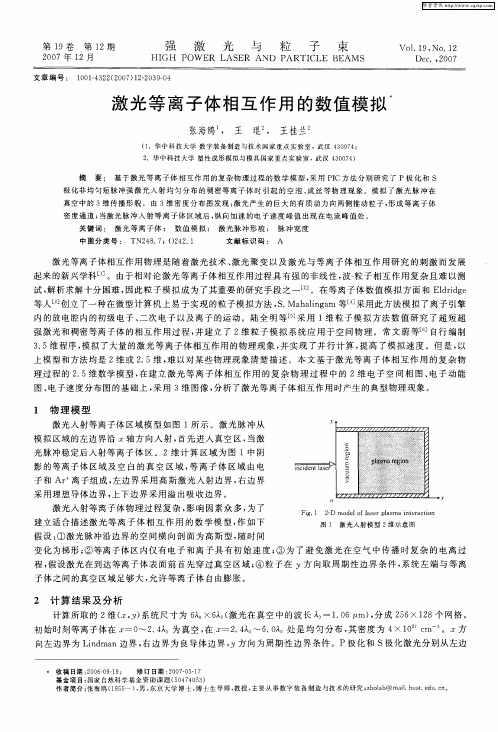
图、 电子 速度分 布图的基础 上 , 采用 3 图像 , 维 分析 了激光 等离子 体相 互作 用时产生 的典型 物理现 象 。
1 物 理 模 型
激光 入射等离子 体 区域模 型 如图 1 示 。激 光 脉 冲从 所 模 拟 区域 的左边界 沿 z轴方 向入 射 , 首先 进入 真空 区 , 当激 光 脉 冲稳定 后入射 等离子 体 区 。2维 计 算 区域 为 图 1中阴 影 的等离子 体 区域及 空 白的 真 空 区域 , 等离 子 体 区域 由电 子 和 Ar 离子组 成 , 左边 界采 用高 斯激 光入 射边界 , 右边 界 采 用理 想导体边 界 , 上下 边界 采用 溢 出吸 收边界 。 激光 入射 等离子体 物理过 程 复杂 , 响 因素众 多 , 了 影 为 建 立适合 描述激 光 等离 子 体 相互 作 用 的数 学模 型 , 如 下 作 假 设 : 激光脉 冲沿边界 的空 间横 向剖 面 为高斯 型 , 时间 ① 随 变化 为梯 形 ; 等离子体 区 内仅有 电子 和 离子 具 有初 始速 度 ; 为 了避 免 激光 在空 气 中传播 时 复 杂 的 电离 过 ② ③ 程 , 设激光 在到达等 离子体 表 面前 首先 穿过真 空区域 ; 粒子 在 Y方 向取 周期性 边界 条 件 , 假 ④ 系统左 端 与 等离 子体 之间 的真 空区域 足够大 , 允许 等离 子 体 自由膨胀 。
真空 中的 3 传 播 形 貌 。 由 3维 密 度 分 布 图发 现 : 光 产 生 的 巨 大 的 有 质 动 力 向两 侧推 动 粒 子 , 成 等 离 子体 维 激 形
密 度通 道 ; 当激 光 脉 冲 入 射 等 离 子 体 区域 后 , 向加 速 的 电子 速 度 峰 值 出现 在 电 流 峰 值处 。 纵 关 键 词 : 激 光 等 离 子 体 ; 数 值 模 拟 ; 激 光 脉 冲 形貌 ; 脉 冲 宽 度
激光等离子体中一些基本过程及其应用

激光等离子体中一些基本过程及其应用郑春阳北京应用物理与计算数学研究所2008年10月16日北大I.基本概念II.黑腔激光等离子体相互作用过程(LPI)III.强场与“快点火”中LPIIV.激光天体物理I.基本概念(1)激光与非磁化等离子体相互作用主要涉及三种波:激光(电磁波)、电子等离子体波(Langmuir波)及离子声波(1)电磁波:ω2=ωp 2+k 2c 2(光子似乎得到“质量”m*c 2=h ωp )ωL = ωp 对应n c =1.1×1021/λL 2cm -3(稀薄或稠密)(2)Langmuir 波: ω2=ωp 2+3k 2λD 2(λD =v th,e / ωp )存在条件:v ph =ω/k ﹥﹥v th,e (Landau 阻尼)(3)离子声波:ω=c ia k, c ia =(Zk B T e /m i )1/2(ZT e /T i )1/2>1在实际应用中,对等离子体中存在的大量集体模式(波、不稳定性)的激发、非线性耦合、时空演化的理解是至关重要的。
I.基本概念(2)不同强度、波长的激光等离子体相互作用性质差异可以很大。
我们关心的是电子在激光电场中的振荡能量与它们的热能量可比较≈1021cm-3,T e≈1keV考虑:neI L~c|E L|2/8π~cn e K B T~1015W/cm2v osc>v e激光惯性约束聚变(ICF)激光装置产生的强度范围激光强度I~1018W/cm2,v osc~c属于相对论强场物理范围。
L激光等离子体过程为高度非线性,必须动力学手段描述。
I.基本概念(3)非常重要的量:有质动力(Ponderomotive force)Convective term有质动力:光压梯度,把电子从高场强区推开(光通道、成丝)对线偏振激光:2ω项,激发高次谐波II.激光间接驱动黑腔中激光等离子体非线性相互作用问题Capsule LEH激光的吸收机制-逆韧致吸收逆韧致吸收和共振吸收:ICF(低强度、长脉冲)最重要的两种吸收机制。
超强激光等离子体相互作用中EQD效应的研究

电子科技大学UNIVERSITY OF ELECTRONIC SCIENCE AND TECHNOLOGY OF CHINA博士学位论文DOCTORAL DISSERTATION论文题目超强激光等离子体相互作用中QED效应的研究学科专业物理电子学学号201211040618作者姓名田云先指导教师李建清教授分类号密级UDC注1学位论文超强激光等离子体相互作用中QED效应的研究(题名和副题名)田云先(作者姓名)指导教师李建清教授电子科技大学成都(姓名、职称、单位名称)申请学位级别博士学科专业物理电子学提交论文日期2018.04.04 论文答辩日期2018.06.05学位授予单位和日期电子科技大学2018年6月答辩委员会主席评阅人注1:注明《国际十进分类法UDC》的类号。
Research on the QED Effect of Ultrahigh IntensityLaser-Plasma InteractionA Doctoral Dissertation Submitted toUniversity of Electronic Science and Technology of ChinaDiscipline: Physical ElectronicsAuthor: Tian YunxianSupervisor: Prof. Li JianqingSchool: School of Electronics Science and Engineering摘要人类对能源的急迫需求促进了新能源——聚变能的飞速发展,聚变能中的惯性约束聚变由于可控性、无污染以及原料成本低(海水中的氘氚)等优势受到国内外学者极其广泛的关注。
随着对惯性约束聚变研究的深入,脉冲激光的强度也在不断提高,特别是近年来激光关键技术——激光放大器技术的突破,使得目前最高激光脉冲峰值功率已经达到1022 W/cm2,并有望达到1023~1024 W/cm2甚至更高。
混合流体-pic物理建模及其在激光聚变中的应用
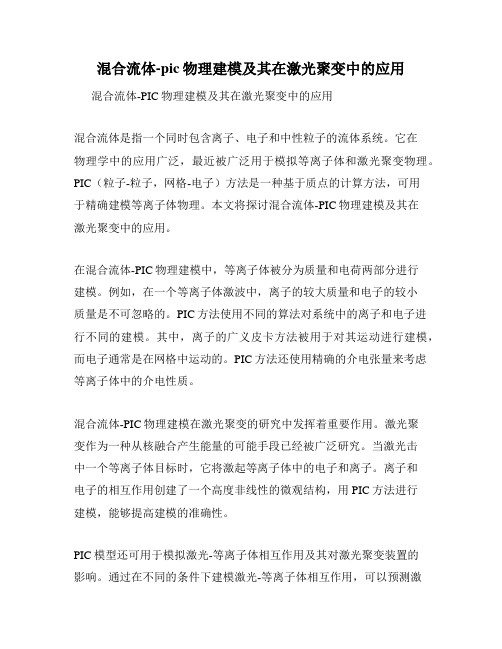
混合流体-pic物理建模及其在激光聚变中的应用混合流体-PIC物理建模及其在激光聚变中的应用混合流体是指一个同时包含离子、电子和中性粒子的流体系统。
它在物理学中的应用广泛,最近被广泛用于模拟等离子体和激光聚变物理。
PIC(粒子-粒子,网格-电子)方法是一种基于质点的计算方法,可用于精确建模等离子体物理。
本文将探讨混合流体-PIC物理建模及其在激光聚变中的应用。
在混合流体-PIC物理建模中,等离子体被分为质量和电荷两部分进行建模。
例如,在一个等离子体激波中,离子的较大质量和电子的较小质量是不可忽略的。
PIC方法使用不同的算法对系统中的离子和电子进行不同的建模。
其中,离子的广义皮卡方法被用于对其运动进行建模,而电子通常是在网格中运动的。
PIC方法还使用精确的介电张量来考虑等离子体中的介电性质。
混合流体-PIC物理建模在激光聚变的研究中发挥着重要作用。
激光聚变作为一种从核融合产生能量的可能手段已经被广泛研究。
当激光击中一个等离子体目标时,它将激起等离子体中的电子和离子。
离子和电子的相互作用创建了一个高度非线性的微观结构,用PIC方法进行建模,能够提高建模的准确性。
PIC模型还可用于模拟激光-等离子体相互作用及其对激光聚变装置的影响。
通过在不同的条件下建模激光-等离子体相互作用,可以预测激光聚变的产生条件和效率。
PIC模型还可以用于研究不同的激光聚变反应,以确定最适合激光聚变产生的条件和系统设计。
总之,混合流体-PIC物理建模是研究等离子体物理学和激光聚变的重要工具。
它可以提高研究人员对微观结构和相互作用的理解和感知。
随着技术的不断发展和计算能力的不断提高,PIC模型将在未来的研究中发挥着更加广泛的作用。
激光等离子体中高能电子各向异性压强的粒子模拟

激光等离子体中高能电子各向异性压强的粒子模拟王宬朕;董全力;刘苹;吴奕莹;盛政明;张杰【摘要】Direct-drive inertial confinement fusion (ICF) requires a symmetric compression of the fuel target to achieve physical conditions for the ignition.The fast ignition scheme reduces the symmetry requirements for the target compression and the necessary driving energy,but symmetrically compressed target will certainly help improve the efficiency of the nuclear fuel burning.In this paper,with the particle-in-cell (PIC) simulation method,characteristics of the anisotropic pressure tensor of hot electrons are reported for the ultra intense laser pulse interaction with over dense plasmas,which mimics the scenario of the last stage when hot electrons are utilized to ignite the compressed fuel core in the ICF fast ignition scheme.A large number of hot electrons can stimulate pressure oscillations in the high density plasma.As the component parallel to the electron velocity dominates the pressure tensor,the electron density distribution perturbation propagates rapidly in this direction.In order to keep those hot electrons in the high density fuel plasma core for a period long enough for them to deposit energy and momentum,a magnetic field perpendicular to the electron velocity is used.The PIC simulation results indicate that the hot electrons can be trapped by the magnetic field,and the components of the anisotropic pressure tensor related to the parallel direction are significantly affected,thereby producing a high peak near the incidence surface.Since it is a relatively long process for the energy transfer from electrons to fuelions and the nuclear interaction to be completed,the fluid effects take their roles in the fuel target evolution.The anisotropic electron pressure will deteriorate the fuel core symmetry,reduce the density,and achieve a lower efficiency of nuclear fuel burning and a lower gain of nuclear reaction than expected.The effects of the hot electron anisotropic pressure tensor in the fast ignition scheme should be considered as a factor in experiments where the nuclear reaction gain is measured to be much lower than the theoretical prediction.%直接驱动惯性约束聚变(ICF)的实现需要对靶丸进行严格的对称压缩,以达到自持热核反应(点火)所需的条件.快点火方案的应用降低了对靶丸压缩对称性以及驱动能量的要求,但压缩及核反应过程中良好的靶丸对称性无疑有助于核反应增益的提高.本文研究了快点火方案中高能电子注入高密等离子体后导致的各向异性电子的压强张量.这一现象存在于ICF快点火方案中的高能电子束“点火”及核反应阶段.鉴于高能电子加热离子过程以及靶丸核反应自持燃烧过程的时间较长,高密靶核会由于超高的各向异性压强的作用破坏高密靶丸的对称性,降低核燃料密度,进而降低了核燃料燃烧效率以及核反应增益.【期刊名称】《物理学报》【年(卷),期】2017(066)011【总页数】9页(P224-232)【关键词】各向异性压强;粒子模拟;快点火【作者】王宬朕;董全力;刘苹;吴奕莹;盛政明;张杰【作者单位】鲁东大学物理与光电工程学院,烟台264000;鲁东大学物理与光电工程学院,烟台264000;上海交通大学IFSA协同创新中心,上海 200240;鲁东大学物理与光电工程学院,烟台264000;鲁东大学物理与光电工程学院,烟台264000;上海交通大学物理与天文学院,上海200240;上海交通大学IFSA协同创新中心,上海200240;上海交通大学物理与天文学院,上海200240;上海交通大学IFSA协同创新中心,上海 200240【正文语种】中文直接驱动惯性约束聚变(ICF)的实现需要对靶丸进行严格的对称压缩,以达到自持热核反应(点火)所需的条件.快点火方案的应用降低了对靶丸压缩对称性以及驱动能量的要求,但压缩及核反应过程中良好的靶丸对称性无疑有助于核反应增益的提高.本文研究了快点火方案中高能电子注入高密等离子体后导致的各向异性电子的压强张量.这一现象存在于ICF快点火方案中的高能电子束“点火”及核反应阶段.鉴于高能电子加热离子过程以及靶丸核反应自持燃烧过程的时间较长,高密靶核会由于超高的各向异性压强的作用破坏高密靶丸的对称性,降低核燃料密度,进而降低了核燃料燃烧效率以及核反应增益.惯性约束聚变中心点火方案是指在非常短的时间尺度内利用高能量高功率密度的脉冲激光均匀照射氘氚燃料靶丸[1],该过程产生的靶面物质等离子体外向喷射的反冲作用将靶内物质快速地压缩至超高密度(约为1024cm−3)、超高温度(约为108K)和超高压强(约为1010atm)状态[2],同时利用物质自身的惯性将该状态维持一定的时间(约为10−9s)[3],使之达到自持热核反应所需条件,业内称之为“点火”[4].为了能够将靶丸顺利地压缩至以上状态,需要在压缩过程中严格保持靶丸的对称性.影响靶丸对称压缩的初始性条件有很多,包括驱动光源的对称性、作为热核燃料靶丸的球形度、壁厚的均匀性、表面粗糙度、壳层密度分布、壳层材料的组成和掺杂水平以及靶丸装配偏心程度等.在惯性约束聚变(ICF)的内爆实验中,通常对称布置多路高能量、高功率密度的脉冲激光[5,6],同时照射到球形氘氚靶丸上.靶压缩对称性对激光辐照的空间分布极为敏感.驱动光源光束强度的不均匀性易激发压缩靶面的流体力学稳定性,如Richtmyer-Meshkov(RM)不稳定性等[7,8].为实现高效的对称内爆和高增益,其驱动辐照不均匀性必须控制到1%以下[2,5].靶丸表面的粗糙度以及小尺度的靶面变形也会导致内爆压缩过程中流体力学不稳定性的出现与增长[5,9−11].瑞利-泰勒不稳定性是影响激光内爆对称压缩靶丸的重要问题之一,容易发生在内爆压缩的加速阶段和减速阶段[12].它能够使靶丸初始的不均匀特征在压缩过程中呈指数增长,从而极大地降低靶丸结构的对称和完整,破坏性很大[13,14].在美国国家点火装置上进行的惯性约束聚变氘氚内爆实验中,测量到的中子产额和热斑压强明显低于模拟数值,其原因就是因为靶丸的面密度不均匀性破坏了压缩壳层的稳定性,并且极大地影响了内爆动能转化为热斑内能[15].针对中心点火方案中出现的流体力学不稳定性导致的靶丸压缩问题,业内提出了将“压缩”和“点火”两个过程分开进行的“快点火”技术方案[16].在压缩阶段利用纳秒长脉冲激光束对靶丸进行高度对称压缩,当聚变燃料被均匀压缩到最大密度时,将一束超短脉冲强激光聚焦在靶丸表面(光强>1020W/cm2),极高的有质动力在靶丸表面的等离子体临界密度面上“打洞”,并将临界密度面向靶芯的高密核处挤压.在这个过程中产生的大量的能量高达MeV的电子穿透临界密度面射入高密核,并将能量传输给核燃料离子,使其温度迅速升至点火所要求的5—10 keV的高温,实现对靶丸的快速点火.由于ICF快点火方案降低了对靶设计、光束质量以及辐照均匀性的严格要求,因而很快成为ICF研究中的一个重要方向.科学家们对快点火方案涉及的诸多物理和技术问题进行了理论与分解实验研究,并取得了较好的研究结果.比如,针对“点火”过程需要的超短脉冲强激光及其所产生的高能电子在高密核外围等离子体中存在各种传输不稳定性,通过采用锥球靶,吴凤娟等[17]对强激光与锥型三明治结构靶相互作用快电子束的产生与传输进行了粒子模拟,并且在相同激光参数下与其他锥型靶的作用结果进行了比较.采用锥型靶的目的就是让点火激光脉冲通过锥壳屏蔽的空间直接与压缩后的高密度靶核相互作用,产生高能电子实施点火,避免了激光以及高能电子在较低密等离子体区的传输不稳定性,提高了靶丸核反应效率与中子产额[18].2005年,谷渝秋等[19]利用3 TW飞秒激光器与固体靶相互作用,研究了超热电子构成各向异性的能量分布,而针对快点火中相对论电子束能量沉积的问题,周沧涛等[20,21]在物理建模、程序研制以及数值模拟研究等方面做了大量工作,同时在激光驱动强流电子束的产生和控制方面做了细致的研究.快点火方案中,高能电子束注入到高密靶核里,需要有效地将其能量淀积给燃料离子,同时也给高密靶丸带来了对称性问题.由于高能电子仅从一个方向注入,其所造成的压强张量必然是各向异性的.在电子将能量转移给燃料离子以及核反应持续发生这一较长时间内,电子各向异性压强张量预期将通过影响核燃料的空间分布,进而影响到核燃料的燃烧效率及核反应过程的增益.但之前的研究显然对此效应影响点火过程及结果缺乏评估与研究[22].本文利用一维粒子模拟(PIC),研究了激光等离子体相互作用过程中产生的高能电子[23]及其对等离子体内部产生的超高压强的各向异性特征.由于目前人们通过在快点火方案压缩阶段结束后引入外加磁场来引导或者束缚高能电子对高密压缩核的注入及能量淀积[24],本文亦研究了背景磁场对各向异性电子压强张量的影响.压强张量的定义式为[25−30]其中f为电子的速度分布函数,为电子平均速度,me表示电子质量,v表示电子速度.我们将电子数密度表示为最终可以将(1)式压强张量的积分形式改写成(2)式中的⟨···⟨表示对其中的物理量进行加权平均.所以靶物质内某点处的压强状态在直角坐标系下可以表示为张量:压强张量有6个独立分量.物体在压强张量作用下的形变分为体积变化和形状变化两部分,其中体积变化取决于各向同性压强,形状变化取决于各向异性压强.我们将压强张量Pe进行分解,取三个主轴Pexx,Peyy,Pezz中数值最小的分量记为标量压强Pem,构成各向同性压强张量;用压强张量减去各向同性压强张量之后得到的就是导致形变的各向异性压强张量,记作πeij.于是有若系统处在热平衡状态,人们可以利用理想气体状态方程计算各向同性压强:其中Pe为电子的标量压强,ne为电子数密度,kB=1.38×10−23J/K为玻尔兹曼常数,Te=mev2/(3kB)为电子温度.多粒子系统通过粒子间的相互作用实现能量和动量的交换,最终达到热平衡态[29,31−35].可以大致估算一下激光等离子体需要经过多长时间能达到平衡.电子的碰撞频率νee=2.91×10−6nelnΛT−3/2es−1,其中ne=1027m−3,lnΛ=10,Te=108K,可计算出电子的碰撞频率大约为1010s−1.若我们设置的激光脉宽为1 ns,则电子碰撞一次大概需要经历1/10个激光脉冲的时间,即在激光脉冲时间内,电子可运动至平衡状态.但实验表明较高能量的激光可能会产生部分高能电子.这部分电子可占总数的1/10,其温度可达几百keV,热化过程比较慢,且其能量空间分布亦不均匀,必须直接利用压强张量定义式对各向异性压强张量πe进行计算.在本文中我们利用一维PIC模拟产生各向异性分布的高能电子并探讨其压强张量Pe的特征.3.1 PIC模拟参数设置模拟中我们对激光场的部分参数进行了如下设置:无量纲化的电场振幅峰值为2.7;激光波长为1µm;激光场的功率密度I=1.0×1019W/cm2;脉冲包络为高斯型,脉宽τ=30τ0≈100 fs,τ0为激光周期;激光的入射角度为45°;偏振方向为P偏振;初始的电子温度设置为2.0 eV.图1(a)中红线给出了靶物质的初始电子密度分布,横坐标是以波长λ为单位的空间长度L,右侧纵坐标是以临界密度nc归一化的电子密度.横坐标8λ—16λ是电子密度分布为e指数增长区域,16λ—20λ是电子密度为5nc且均匀分布的高密区域,0—8λ和20λ—28λ是密度为零的真空区域,临界密度nc的位置在13.5λ处.考虑到激光等离子体中存在极强的自生磁场,而且在ICF快点火方案压缩阶段结束后,可利用外加磁场进行高能电子注入引导或者约束提高其能量向燃料离子的淀积效率.我们还将讨论背景磁场对各向异性压强特征的影响.3.2 无背景磁场条件下各向异性压强的特征图1 是在激光与靶物质相互作用过程中,电子密度(图1(a))以及电子动量(图1(b))的时空分布.由于在临界密度处激光场强梯度最大,有质动力一方面导致电子密度凹坑的形成,另一方面将电子加速至超高能量.当这些高能电子进入到高密区域,激发了高密区域等离子体的振荡,如图1(a)中黑线表示的75τ0时刻的电子密度分布(右侧纵坐标)所示.图1(a)中的电子密度的时空演化(左侧纵坐标,时间t)更加清晰地体现出这一点.从图1(b)的电子动量的时空分中可以看出,电子动量空间分布具有一定的周期性,这显示了高能电子主要是由激光有质动力加速而成,这些高能电子进入到高密区域后保留了这一群特征.同时随着激光作用时间的延续,高密区域中高能电子的动量以及数目明显地增大、增多,其加速机制获取的周期性特征在100τ0后逐渐消失. 图2 (a)和图2(b)是在16λ—19λ的高密区域中利用(5)式求得的各向同性压强Pe 和利用压强张量分量求得的各向同性压强Pem的时空分布图.从图2(a)中可以看出,各向同性压强随时间变化得比较平缓,在空间分布上也呈现出较为均匀的态势.但图2(b)呈现出与图2(a)不同的趋势,Pem的时空演化有较大振荡,而在数值上也明显比Pe要小1/20之多.从图2(c)在X方向的电子动量的时空分布可知,在50τ0时刻以后,高密区域才开始有高能电子进入,与此同时图2(d)中电子的压强张量分量Pexx 也开始逐步增大,并且可以发现压强张量分量Pexx随着X方向的电子动量pe的变化而变化,二者几乎是同步进行的,表明在高密区域的压强张量是由于电子的进入而导致的.压强张量是各向同性和各向异性压强之和,当电子达到热平衡状态之后,则表现出各向同性压强的特征及性质,但高能电子却由于短时间内无法达到热平衡态,主要导致各向异性压强.图3(a)给出了65τ0时刻各向异性压强张量πe的6个独立分量,可见6个压强分量无论是在大小、方向,还是在变化趋势上均有较大差异.最明显的差异是各个方向上的压强分量大小不尽相同.πexx是其中最大的各向异性压强分量值,而πezz值最小.πexx,πeyy和πexy明显地以不同的振动幅度随着空间变化而振荡,其原因是电子被激光有质动力加速的过程中,产生的电子动量具有一定的空间周期性.所以高密区域内各向异性压强的产生归因于空间分布不均匀的高能电子群.图3 (b)是在75τ0(红色线条)和85τ0(蓝色线条)两个时刻的各向异性压强πexx随空间的变化情况.图中虚线表示低能电子对πexx的贡献,点线表示高能电子对πexx 的贡献,实线则表示高密区域内总的各向异性压强πexx值.从图3(b)可以更清晰地看出,高能电子对πexx的贡献远超出低能电子,并且在总的各向异性压强πexx中占据主导地位.图3(c)和图3(d)分别是高密区域中高能电子和低能电子对各向异性压强πexx贡献的时空演化图.随着作用时间的延长,低能电子对各向异性压强的贡献逐渐减少,最终趋于一个较小且稳定的数值范围.从数目上看,高密区域中的高能电子数目远远小于低能电子.在65τ0时刻以前高能电子所占比例不到总电子数的5%,75τ0时刻为止所占比例不超过15%,而85τ0时刻及以后高能电子所占比例基本趋于一个稳定值,大约为总电子数的20%.即便数目比例如此小,高能电子却在各向异性压强中占据了大约80%—90%的贡献值,是各向异性压强的主要贡献者.这说明当激光等离子体相互作用过程中,产生的大量低能电子在经历一段时间之后会趋于热平衡状态,表现出较强的各向同性,而高能电子则可能由于热化过程较慢,并未达到一个热平衡态,导致其各向异性较为突出.在直接驱动惯性约束聚变实验中靶丸如此巨大的各向异性超高压,主要是由激光与靶丸作用过程中产生的各向异性的高能电子造成的.同时我们也注意到85τ0时刻的πexx值比75τ0时刻的πexx值要大得多,并且高能电子的贡献比值也进一步增大了,这是因为进入高密区域内的高能电子的数目以及动量都有所增大.3.3 背景磁场对各向异性压强的影响激光等离子体内自生磁场是相当复杂的,本文仅讨论当加入大小0.1 T、垂直激光入射方向(模拟设置为Z轴正方向)的背景磁场的情形下高密区域内各向异性压强的特征.图4(a)是60τ0时刻等离子体高密区域电子相空间图,给出了背景磁场对高能电子动量分布的影响.选取相同时刻(60τ0)电子在高密区域沿X方向的动量分布,红色点表示无背景磁场时电子的动量,蓝色点则是存在背景磁场时的电子动量.可以看出,在相同作用时间的情况下,无背景磁场约束的高能电子保持了激光有质动力加速特征,在整个区域内的分布具有一定的空间周期性;而背景磁场的洛伦兹力却束缚了高能电子,将其阻滞在高密区域的前端,仅使其中很少一部分能进入深层区域.图4(b)是65τ0时刻存在背景磁场时各向异性压强张量πe的6个分量.从6个压强分量的整体变化来看,振荡幅度相差较大,而且各个压强分量值主要集中在高密区域的前端,深层区域内的各个压强分量值都比较小,基本都是此区域内的低能电子的贡献.与无背景磁场条件下的各向异性压强张量分量图3(a)进行比较可以看出,在正X方向上的压强πexx比无背景磁场时的数值小5—7倍之多,且随着空间改变整体呈减小的趋势;在正Y方向上的压强πeyy也随着空间改变整体呈减小的趋势;但与背景磁场平行的正Z方向上的压强πezz其大小及方向与无背景磁场条件下的πezz相差不大明显.两图的比较显示,在Z方向上的背景磁场对各向异性压强分量πexx,πeyy和πexy的影响较为明显,而对πezz的影响较小.图4(c)和图4(d)是存在背景磁场时高密区域内低能电子和高能电子分别对各向异性压强πexx的贡献情况,可以看出,低能电子对πexx的贡献比高能电子的贡献小了近10倍之多,但随着作用时间的延长,其贡献逐渐减小,并趋于一个较稳定的值;而高能电子的贡献则主要集中在高密区域的前端,并随着空间的改变压强值逐渐减小.由高能电子引起的高密区域内的各向异性压强会导致对称压缩的高密靶丸在超高压强的作用下体积膨胀增大,进而引起靶丸密度的降低.我们假设在高能电子注入之初为等压膨胀,当5.0×108atm的压强作用在半径为100µm,密度达到300 g/cm3的高密靶核时,靶丸的半径会在2 ps内迅速从原来的100µm增大到150µm,其密度也会由初始的300 g/cm3减小到100 g/cm3以下,如此低的靶丸密度将会明显地降低核燃料燃烧效率以及核反应增益.本文利用一维PIC模拟程序,研究了激光与等离子体相互作用过程中产生的高能电子传输到高密度区域后导致的压强张量特征改变.研究表明,等离子体高密区域内各向异性压强主要是由高能电子造成的.本文也研究了背景磁场对各向异性压强的影响,研究结果发现,在垂直于背景磁场方向上,因电子被磁场束缚,其各向异性压强张量分量的数值要大于平行于背景磁场方向上的压强分量;垂直方向上压强分量的空间变化也比平行分量要剧烈.在快点火方案中,在靶丸压缩结束后,高能电子向燃料离子的能量传递过程以及随后的核反应过程非一蹴而就,而是需要相对较长的时间.在这段时间内,流体力学效应比较明显,高能电子的各向异性压强势必会影响到燃料的空间分布,进而影响燃烧效率以及中子的产额.本文对高能电子各向异性压强张量的研究意在提醒人们关注这一点.[1]Craxton R S,Anderson K S,Boehly T R,Goncharov V N,Harding DR,Knauer J P,McCrory R L,McKenty P W,Meyerhofer D D,Myatt J F,Schmitt A J,Sethian J D,Short R W,Skupsky S,Theobald W,Kruer W L,Tanaka K,Betti R,Collins T J B,Delettrez J A,Hu S X,Marozas J A,Maximov A V,Michel DT,Radha P B,Regan S P,Sangster T C,Seka W,Solodov A A,Soures JM,Stoeckl C,Zuegel J D 2015 Phys.Plasmas 22 110501[2]Lindl J 1995 Phys.Plasmas 2 3933[3]Drake R P 2006 High-Energy-Density Physics:Fundamentals,Inertial Fusion,and Experimental Astrophysics(1st Ed.)(Berlin:SpringerScience&Business Media)pp392–419[4]McCrory R L,Meyerhofer D D,Betti R,Craxton R S,Delettrez J A,Edgell DH,Glebov V Yu,Goncharov V N,Harding D R,Jacobs-Perkins D W,Knauer J P,Marshall F J,McKenty P W,Radha P B,Regan S P,Sangster T C,SekaW,Short R W,Skupsky S,Smalyuk V A,Soures J M,Stoeckl C,YaakobiB,Shvarts D,Frenje J A,Li C K,Petrasso R D,Séguin F H 2008 Phys.Plasmas 15 055503[5]Rosen M D 1999 Phys.Plasmas 6 1690[6]Bodner S E,Colombant D G,Gardner J H,Lehmberg R H,Obenschain S P,Phillips L,Schmitt A J,Sethian J D 1998 Phys.Plasmas 5 1901[7]Sharp D H 1984 Physica D 12 3IN111[8]Brouillette M 2002 Annu.Rev.Fluid Mech.34 445[9]Wesson J,Campbell D J 2011 Tokamaks(4th Ed.)(Oxford:Oxford University Press)pp356–358[10]Li C K,Séguin F H,Frenje J A,Petrasso R D,Delettre z JA,McKenty PW,Sangster T C,Keck R L,Soures J M,Marshall F J,Meyerhofer DD,Goncharov V N,Knauer J P,Radha P B,Regan S P,Seka W 2004Phys.Rev.Lett.92 205001[11]Shigemori K,Azechi H,Nakai M,Honda M,Meguro K,Miyanaga N,Takabe H,Mima K 1997 Phys.Rev.Lett.78 250[12]Honda M,Mima K,Shigemori K,Nakai M,Azechi H,Nishiguchi A 1999 Fusion Eng.Des.44 205[13]Lindl J D,McCrory R L,Campbell E M 1992 Phys.Today 45 32[14]Wouchuk J G 2001 Phys.Rev.E 63 056303[15]Gu J F,Dai Z S,Fan Z F,Zou S Y,Ye W H,Pei W B,Zhu S P 2014Phys.Plasmas 21 012704[16]Tabak M,Hammer J,Glinsky M E,Kruer W L,Wilks S C,WoodworthJ,Campbell E M,Perry M D 1994 Phys.Plasmas 1 1626[17]Wu F J,Zhou W M,Shan L Q,Li F,Liu D X,Zhang Z M,Li B Y,Bi B,WuB,Wang W W,Zhang F,Gu Y Q,Zhang B H 2014 Acta Phys.Sin.63 94101(in Chinese)[吴凤娟,周维民,单连强,李芳,刘东晓,张智猛,李博原,毕碧,伍波,王为武,张锋,谷渝秋,张保汉2014物理学报63 94101][18]Kodama R,Norreys P A,Mima K,Dangor A E,Evans R G,Fujita H,Kitagawa Y,Krushelnick K,Miyakoshi T,Miyanaga N,Norimatsu T,Rose S J,ShozakiT,Shigemori K,Sunahara A,Tampo M,Tanaka K A,Toyama Y,YamanakaT,Zepf M 2001 Nature 412 798[19]Gu Y Q,Cai D F,Zheng Z J,Yang X D,Zhou W M,Jiao C Y,Chen H,Wen T S,Chunyu S T 2005 Acta Phys.Sin.54 186(in Chinese)[谷渝秋,蔡达锋,郑志坚,杨向东,周维民,焦春晔,陈豪,温天舒,淳于书泰2005物理学报54 186][20]Wu S Z,Zhang H,Zhou C T,Wu J F,Cai H B,Cao L H,He M Q,Zhu S P,He X T 2015 High Power Laser and Particle Beams 27 77(in Chinese)[吴思忠,张华,周沧涛,吴俊峰,蔡洪波,曹莉华,何民卿,朱少平,贺贤土2015强激光与粒子束27 77] [21]Cai H B,Zhou C T,Jia Q,Wu S Z,He M Q,Cao L H,Chen M,Zhang H,Liu J,Zhu S P,He X T 2015 High Power Laser and Particle Beams 27 27032001(in Chinese)[蔡洪波,周沧涛,贾青,吴思忠,何民卿,曹莉华,陈默,张华,刘杰,朱少平,贺贤土2015强激光与粒子束27 27032001][22]Zhang J 1999 Physics 28 0(in Chinese)[张杰1999物理28 0][23]Cassak P A,Baylor R N,Fermo R L,Beidler M T,Shay M A,SwisdakM,Drake J F,Karimabadi H 2015 Phys.Plasmas 22 020705[24]Wang W M,Gibbon P,Sheng Z M,Li Y T 2015 Phys.Rev.Lett.114 015001[25]Divin A,Markidis S,Lapenta G,Semenov V S,Erkaev N V,Biernat H K 2010 Phys.Plasmas 17 122102[26]Hoshino M 2005 J.Geophys.Res.110 A10215[27]Liu C,Fox W,Bhattacharjee A 2015 Phys.Plasmas 22 053302[28]Wan W G,Lapenta G 2008 Phys.Rev.Lett.101 015001[29]Yin L,Winske D,Gary S P,Birn J 2001 J.Geophys.Res.106 10761[30]Wang L,Hakim A H,Bhattacharjee A,Germaschewski K 2015Phys.Plasmas 22 012108[31]Mottez F 2004 Ann.Geophys.22 3033[32]Heinz H,Paul W,Binder K 2005 Phys.Rev.E 72 066704[33]Cai H S,Li D 2009 Phys.Plasmas 16 052107[34]Le A,Daughton W,Karimabadi H,Egedal J 2016 Phys.Plasmas 23 032114[35]Yin L,Winske D 2003 Phys.Plasmas 10 1595PACS:52.27.–h,52.38.–r,52.65.–y,52.65.RrDOI:10.7498/aps.66.115203 Direct-drive inertial con fi nement fusion(ICF)requires a symmetric compression of the fuel target to achieve physical conditions for the ignition.The fast ignition scheme reduces the symmetry requirements for the target compression and the necessary driving energy,but symmetrically compressed target will certainly help improve the efficiency of the nuclear fuel burning.In this paper,with the particle-in-cell(PIC)simulation method,characteristics of the anisotropic pressure tensor of hot electrons are reported for the ultra intense laser pulse interaction with over dense plasmas,which mimics the scenario of the last stage when hot electrons are utilized to ignite the compressed fuel core in the ICF fast ignition scheme.Alarge number of hot electrons can stimulate pressure oscillations in the high density plasma.As the component parallel to the electron velocity dominates the pressure tensor,the electron density distribution perturbation propagates rapidly in this direction.In order to keep those hot electrons in the high density fuel plasma core for a period long enough for them to deposit energy and momentum,a magnetic fi eld perpendicular to the electron velocity is used.The PIC simulation results indicate that the hot electrons can be trapped by the magnetic fi eld,and the components of the anisotropic pressure tensor related to the parallel direction are signi fi cantly a ff ected,thereby producing a high peak near the incidence surface.Since it is a relatively long process for the energy transfer from electrons to fuel ions and the nuclear interaction to be completed,the fl uid e ff ects take their roles in the fuel target evolution.The anisotropic electron pressure will deteriorate the fuel core symmetry,reduce the density,and achieve a lower efficiency of nuclear fuel burning and a lower gain of nuclear reaction than expected.The e ff ects of the hot electron anisotropic pressure tensor in the fast ignition scheme should be considered as a factor in experiments where the nuclear reaction gain is measured to be much lower than the theoretical prediction.。
- 1、下载文档前请自行甄别文档内容的完整性,平台不提供额外的编辑、内容补充、找答案等附加服务。
- 2、"仅部分预览"的文档,不可在线预览部分如存在完整性等问题,可反馈申请退款(可完整预览的文档不适用该条件!)。
- 3、如文档侵犯您的权益,请联系客服反馈,我们会尽快为您处理(人工客服工作时间:9:00-18:30)。
3.3.2 &spacetime . . . . . . . . . . . . . . . . . . . . . . . . . . . . . 18
3.3.3 &phasespace . . . . . . . . . . . . . . . . . . . . . . . . . . . . . 20
CONTENTS
i
Contents
1 Introduction
1
2 Receiving and Installing
3
2.1 Plain version . . . . . . . . . . . . . . . . . . . . . . . . . . . . . . . . 3
2.2 Parallel version . . . . . . . . . . . . . . . . . . . . . . . . . . . . . . . 4
3.1.7 Parallel LPIC++ version (¶llel) . . . . . . . . . . . . . . . . 12
3.2 Output . . . . . . . . . . . . . . . . . . . . . . . . . . . . . . . . . . . . 13
3 User's Guide
5
3.1 Input for LPIC++ . . . . . . . . . . . . . . . . . . . . . . . . . . . . . . 5
3.1.1 Laser pulses (&pulse front, &pulse rear) . . . . . . . . . . . . . 5
3.4 Running LPIC++ under PVM . . . . . . . . . . . . . . . . . . . . . . . . . 21
4 Examples
22
4.1 Diagnostics . . . . . . . . . . . . . . . . . . . . . . . . . . . . . . . . . 22
3.1.2 Simulation time (&propagate) . . . . . . . . . . . . . . . . . . . 9
3.1.3 Simulation box, plasma shape and density (&box) . . . . . . . . 10
3.1.4 Particle species (&electrons, &ions) . . . . . . . . . . . . . . . . 10
6.3 Program Flow . . . . . . . . . . . . . . . . . . . . . . . . . . . . . . . . 41
A Moving frame for oblique incidence
50
B Units
53
1
1 Introduction
Particle-In-Cell (PIC) codes are well established tools for kinetic simulations in plasma physics and astro physics. In recent years, the progress in producing intense (I > 1018Wcm;2) ultra-short (< 100fs) laser pulses 1] demanded more and more for kinetic descriptions of the interaction of such laser pulses with plasmas, since high intensities, short time scales and large density gradients occuring lead to the failure of conventional hydrodynamic approaches assuming nonrelativistic dynamics, local thermodynamic equilibrium, etc. New insight has meanwhile been obtained with the guidance of numerical kinetic treatments, mainly PIC simulations, in the eld of absorption of short laser pulses 2, 3, 4], the propagation of short pulses in underdense plasma, wake eld generation, fast electron production 5, 6, 13], magnetic eld generation 6], harmonic generation at overdense plasma surfaces 7, 8, 9, 10], and even in a new discipline of inertial con nement fusion (ICF), the fast ignitor concept 11, 12, 13]. The code LPIC++ presented here, is based on a one-dimensional, electromagnetic, relativistic PIC code that has originally been developed by one of the authors 14] during a PhD thesis at the Max-Planck-Institut fur Quantenoptik for kinetic simulations of high harmonic generation from overdense plasma surfaces 10]. The code uses essentially the algorithm of Birdsall and Langdon 15] and Villasenor and Bunemann 16]. It is written in C++ in order to be easily extendable and has been parallelized to be able to grow in power linearly with the size of accessable hardware, e.g. massively parallel machines like Cray T3E. The parallel LPIC++ version uses PVM for communication between processors. PVM is public domain software, can be downloaded from the world wide web 17]. The power of LPIC++ is mainly based on its clear program and data structure, which uses chained lists for the organization of grid cells and enables dynamic adjustment of spatial domain sizes in a very convenient way, and therefore easy balancing of processor loads. Also particles belonging to one cell are linked in a chained list and are immediately accessable from this cell. In addition to this convenient type of data organization in a PIC code, the code shows excellent performance in both its single processor and parallel version. It is planned to extend the code to three spatial dimensions.
4.6 More Examples . . . . . . . . . . . . . . . . . . . . . . . . . . . . . . . 27
5 Algorithm
29
5.1 Maxwell Equations . . . . . . . . . . . . . . . . . . . . . . . . . . . . . 29
Max-Planck-Institut fur Quantenoptik Hans-Kopfermann-Stra e 1 D-85748 Garching, Germany fax: +49-89-32905200
email: meyer-ter-vehn@mpq.mpg.de pfund@mpq.mpg.de
4.2 Performance . . . . . . . . . . . . . . . . . . . . . . . . . . . . . . . . . 22
4.3 Re ection from Overdense Plasma . . . . . . . . . . . . . . . . . . . . . 22
